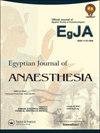Impact of pre-spinal atropine on post spinal hemodynamic and cardiac output measured by electrical cardiometry in cesarean delivery, a randomized controlled trial
IF 0.5
Q3 ANESTHESIOLOGY
引用次数: 0
Abstract
ABSTRACT Background Spinal anesthesia is a widely used technique for cesarean delivery, but it often results in hypotension, bradycardia, and reduced cardiac output (CO). Atropine has a potent muscarinic receptor antagonist activity in the heart. It may be a good choice to prevent post-spinal bradycardia and minimize the marked CO reduction. Methods Sixty pregnant women between the ages of 18 and 40 who were ASA-PS II and planned for elective cesarean delivery were divided into two equal groups at random. Both groups received spinal anesthesia. Atropine group (I) (n = 30): patients received 0.01 mg/kg atropine, while control group (II) (n = 30): patients received the same volume of saline. CO measured by electrical cardiometry (EC) was the primary outcome where, heart rate (HR), mean blood pressure (MBP), stroke volume (SV), systemic vascular resistance (SVR), and neonatal outcomes were the secondary outcomes. Results CO after the intervention was higher in the atropine (group I) than in the control (group II). Also, CO reduction at 5 and 10 min following spinal anesthesia was less in the group I than in the group II. Except for baseline reading, HR was significantly higher in the atropine group versus the control group. MBP was higher in the atropine group than in the control group in all readings. SV and SVR were similar in both groups. Neonatal outcomes were equivalent in both groups. Conclusion Pre-spinal atropine was effective in preventing post-spinal bradycardia and minimized CO reduction in patients undergoing elective cesarean delivery under spinal anesthesia.剖宫产中脊髓前阿托品对脊髓后血流动力学和心输出量测量的影响,一项随机对照试验
本文章由计算机程序翻译,如有差异,请以英文原文为准。
求助全文
约1分钟内获得全文
求助全文
来源期刊

Egyptian Journal of Anaesthesia
Medicine-Anesthesiology and Pain Medicine
CiteScore
0.90
自引率
0.00%
发文量
78
 求助内容:
求助内容: 应助结果提醒方式:
应助结果提醒方式:


